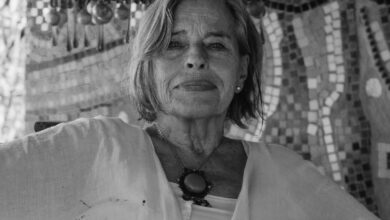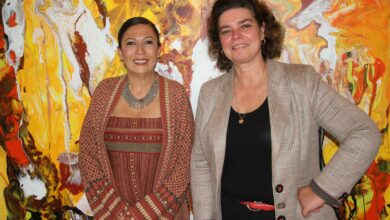There’s an expression in Egyptian dialect that comes from the word parachute, yibarshut, which means to arrive uninvited and benefit from something belonging to other people. Someone can yibarshut on your cigarettes, for example, or on your party.
Art residencies are characterized by this phenomenon. Artists, hosted by a local arts institution and funded by their government or an arts funding body, arrive in a foreign place for a brief period not longer than a few months. Even those who engage with local culture on a superficial level can depart with work that draws interest due to the exotic nature of the residency’s location.
Even though usually no fixed outcome is stipulated, residency programs attract funding because they are meant to facilitate cross-cultural exchange and understanding. Delfina Foundation, which runs a program of artistic exchange among the UK, Middle East and North Africa, says the program is a way to “combat intolerance, isolation and conflict across the world.”
More obvious, residencies also promote artists’ careers. Hito Steyerl and Boris Buden wrote in Etcetera magazine that “like space stations for upwardly mobile self-entrepreneurs, they function as accelerators for self-marketing”.
Cairo has several resident artists operating in its streets at any given time. The Townhouse gallery hosts 14 per year on average, for stays of varying lengths. Artellewa hosts artists, the Contemporary Image Collective (CIC) conducts an exchange residency with Hangar in Barcelona with one person going each way per year, and several institutions for cultural diplomacy such as the Swiss Pro-Helvetia and the Danish Egyptian Dialogue Institute invite foreign artists to work in Cairo. Artists tend to be selected by staff from cultural institutions on both sides, and once the artist is accepted, whatever they chose to do with their time must be accepted as well.
The risk is that the artist will be lazy and uncritical. When artists arrive in a country that is a lot poorer and more religious than their own, the risk increases. By failing to penetrate beyond the host culture’s superficial oddities, artists may reinforce stereotypes and contribute to the “not well thought-through flow of relations,” as Mia Jancowicz of CIC put it, between here and the west.
Recurrent themes appear in the work of Cairo artist residents: numerous films have been made about “garbage city” for example, and there is no shortage of art pieces about the Friday Market. Egyptians’ over-friendliness or tendency to say “Insha Allah” are common subjects. Many artists carry out psycho-geographical walks around the city taking photos; Cairo is dangerously photogenic.
Interesting projects are created, however, when artists alight upon more idiosyncratic elements of Egyptian culture to research.
The Spanish artist Francesc Ruiz, who spent several months in Cairo in 2010 as a resident artist with CIC, resurrected some extinct Egyptian comic book characters and combined them with characters such as Tintin and Donald Duck for a graphic narrative in which the mismatched crew explore downtown Cairo. The audience had to retrace the characters’ steps to pick up ten comic book issues at different locations. With the help of artists here, the piece was made specifically for Cairo, just as Ruiz has made projects that only work in other cities he visited as a resident artist, such as Philadelphia
Adam Broomberg and Oliver Chanarin, who were resident at the Townhouse in 2010, tried to resurrect and research the long-forgotten Egyptian Surrealist movement in an exhibition which changed on a daily basis. They sold cheap limited edition posters, made using the movement’s original rubber stamps on 1930s paper, with that same movement’s fatalistic slogans written in Arabic and English. The two maintain a growing online archive of pictures and texts on the Egyptian Surrealists.
But even when artists do spend a lot of time in Cairo and focus on a project they feel speaks to a local audience, it can still be difficult to connect.
Like anywhere, the art scene here generally looks different and sounds less “local” than the crowds in other places. With exceptions, it tends to be posher and more international – and so the lingua franca is English, which is also the language used by resident artists to communicate with audiences. At talks and openings, one often sees artists searching for Egyptian attendees with whom to speak in order to prove to themselves that they are not simply attracting the usual international art crowd.
The flow of visitors to Egypt has decreased since the 25 January revolution, and that seems to include artists. Hady Kamar, an Egyptian-American artist working in collaboration with Dutch artists Wouter Osterholt and Elke Uitentuis, said the funding for their upcoming project Crowd Control disappeared during the revolution. The project was to deal with the causes and effects of gentrification in Cairo. “A lot of people have said to me that funds have dried up,” Kamar said, and that could be because projects don’t seem relevant to the current events.
Dina Kafafi of the Townhouse said, “As far as Townhouse is concerned, we have received a steady amount of applications for the residency program before and after the revolution, which makes it difficult to speculate what lies ahead.” Alessandro Quaranta, an Italian artist currently at Townhouse, just had his residency pushed back a month for security reasons. The consensus among arts operators is that numbers are likely shoot up before long, as the revolution and the publicity it generated makes Cairo hotter than before.
The revolutionary hype will no doubt result in an increased number of parachuting artists, here to take what they can to create exhibitions that will be eaten up internationally. But as always with art, you never know what you’re going to get. In the words of Jancowicz, “However compromised the situation, there’s always the potential that something beautiful will be done.”




